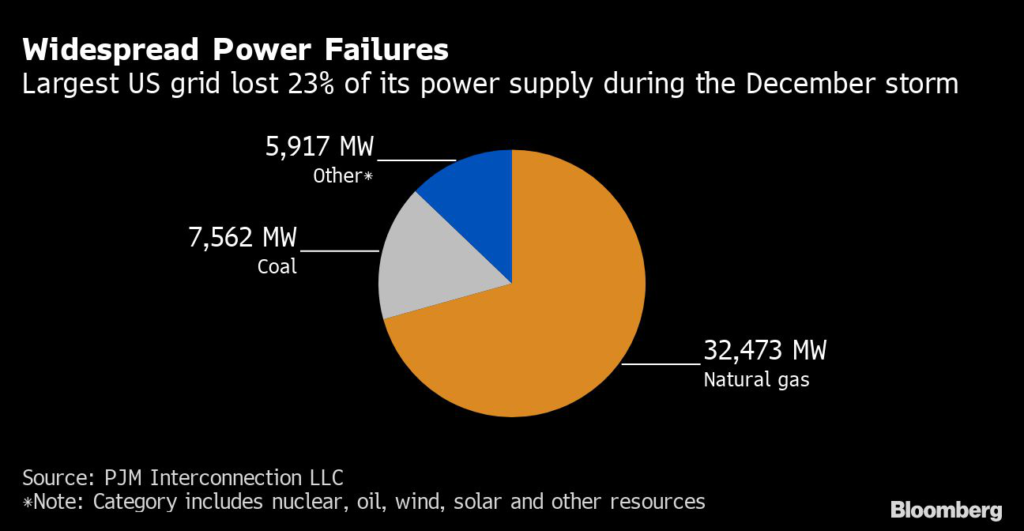The largest US grid operator saw almost one-fourth of power plants serving 65 million people shut down during the Christmas weekend storm, pushing the region to the brink of blackouts.
(Bloomberg) — The largest US grid operator saw almost one-fourth of power plants serving 65 million people shut down during the Christmas weekend storm, pushing the region to the brink of blackouts.
In the first autopsy of the winter freeze that strained PJM Interconnection LLC last month, the grid operator saw 23% of its power-generation fleet shut down on the morning of Dec.
24, according to a presentation released Wednesday. PJM manages the electrical network that stretches from New Jersey to Illinois.
Natural gas-fired plants accounted for 70% of the almost 46 gigawatts of outages and few of the power generators gave notice of impending failure, leaving the grid operator in the lurch as temperatures plunged and electricity demand surged during the holiday weekend.
One gigawatt is enough to power about 800,000 homes in the PJM region.
“Generation outages were unacceptably high and they occurred at the worst possible time,” Donnie Bielak, senior manager of dispatch at PJM, said during the presentation.
The widespread failures that forced PJM to plead with customers to limit electricity use highlighted the network’s vulnerability to volatile weather.
Electricity suppliers that received up-front payouts in exchange for promises to provide emergency power may face up to $2 billion in penalties, according to PJM’s preliminary analysis.
That means PJM could claw back half of the the ratepayer-funded payouts made for the fiscal year that started in June.
That would compare to just $1.1 million in such fines in the prior year.
“A large portion of our generation fleet failed to perform,” Bielak said.
The December storm was historic: Temperatures plunged 29F degrees in a 12-hour period on Dec.
23, the most dramatic drop in a decade, PJM’s analysis showed. Electricity use that afternoon was forecast to reach almost 127 gigawatts, well within the 156 gigawatts of capacity that was expected to be available.
But the chill intensified far faster than anticipated, inflating electricity demand by 10% more than forecast.
Plants unable to cope with the cold began tripping offline and more than 90% of them either alerted PJM with less than an hour’s notice — or no notice at all, Bielak said.
On top of that, another 6 gigawatts of generation — mostly gas-fired units — failed to turn on heading into the Dec.
24 morning peak, crippling efforts to run pumps at some hydro stations. All in all, 57 gigawatts — enough capacity to power 45.6 million households — were out of service in the early hours of Christmas Eve.
“Yet again, system-wide fossil fuel plant failures came close to causing a major disaster,” Tom Rutigliano, senior advocate at the Natural Resources Defense Council, said in a statement.
“PJM must plan accordingly, and reform rules that subsidize fossil fuel power plants by pretending they’re more reliable than they really are.”
PJM is still investigating the event and will release its full analysis in April.
–With assistance from Mark Chediak.
(Updates with scope of potential claw backs in sixth paragraph, NRDC comment in penultimate paragraph.)
More stories like this are available on bloomberg.com
©2023 Bloomberg L.P.










